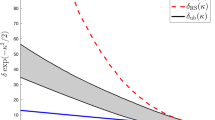Abstract
This paper presents a constructive approach to estimating the size of a neural network necessary to solve a given classification problem. The results are derived using an information entropy approach in the context of limited precision integer weights. Such weights are particularly suited for hardware implementations since the area they occupy is limited, and the computations performed with them can be efficiently implemented in hardware. The considerations presented use an information entropy perspective and calculate lower bounds on the number of bits needed in order to solve a given classification problem. These bounds are obtained by approximating the classification hypervolumes with the volumes of several regular (i.e., highly symmetric) n-dimensional bodies. The bounds given here allow the user to choose the appropriate size of a neural network such that: (i) the given classification problem can be solved, and (ii) the network architecture is not oversized. All considerations presented take into account the restrictive case of limited precision integer weights, and therefore can be directly applied when designing VLSI implementations of neural networks.
Similar content being viewed by others
References
M.A. Arbib (ed.), The Handbook of Brain Theory and Neural Networks, MIT Press: Cambridge, Mass., 1995.
E. Fiesler and R. Beale (eds), Handbook of Neural Computation, Oxford Univ. Press and the Inst. of Physics Publ.: New York, NY, 1996.
V. Beiu, “Entropy bounds for classification algorithms”, Neural Network World, Vol. 6, pp. 497–505, 1996.
S. Draghici and I.K. Sethi, “On the possibilities of the limited precision weights neural networks in classification problems”, in J. Mira, R. Moreno-Díaz and J. Cabestany (eds) Biological and Artificial Computation: From Neuroscience to Technology, Lecture Notes in Computer Science 1240, pp. 753–762, Springer-Verlag: Berlin, June 1997.
V. Beiu and T. De Pauw, “Tight bounds on the size of neural networks for classification problems”, in J. Mira, R. Moreno-Díaz and J. Cabestany (eds) Biological and Artificial Computation: From Neuroscience to Technology, Lecture Notes in Computer Science 1240, pp. 743–752, Springer-Verlag: Berlin, June 1997.
V. Beiu, “Digital integrated circuit implementations”, Chapter E1.4 in [2].
V. Beiu, VLSI Complexity of Discrete Neural Networks, Gordon and Breach: Newark, N.J., 1998.
E.I. Neciporuk, “The synthesis of networks from threshold elements”, Soviet Mathematics - Doklady, Vol. 5, pp. 163–166, 1964 (English transl. in Automation Express, Vol. 7, pp. 27-32 and pp. 35-39, 1964).
O.B. Lupanov, “The synthesis of circuits from threshold elements”, Problemy Kibernetiki, Vol. 20, pp. 109–140, 1973.
J. Bruck and R. Smolensky, “Polynomial threshold functions, AC 0 functions and spectral norms”, SIAM J. Computing, Vol. 21, pp. 33–42, 1992.
K.-Y. Siu, V. Roychowdhury and T. Kailath, “Depth-size tradeoffs for neural computations”, IEEE Trans. on Comp., Vol. C-40, pp. 1402–1412, 1991.
E.B. Baum, “On the capabilities of multilayer perceptrons”, J. Complexity, Vol. 4, pp. 193–215, 1988.
S.-C. Huang and Y.-F. Huang, “Bounds on the number of hidden neurons of multilayer perceptrons in classification and recognition”, IEEE Trans. on Neural Networks, Vol. NN-2, pp. 47–55, 1991.
M. Arai, “Bounds on the number of hidden units in binary-valued three-layer neural networks”, Neural Networks, Vol. 6, pp. 855–860, 1993.
M.H. Hassoun, Fundamentals of Artificial Neural Networks, MIT Press: Cambridge, Mass., 1995.
H. Paugam-Moisy, “Optimisation des réseaux des neurones artificiels”, PhD dissertation, Laboratoire de l'Informatique du Parallélisme LIP-IMAG (http://www.enslyon. fr/LIP/publis.us.html), École Normale Supérieure de Lyon, 46 Allée d'Italie, 69364 Lyon, France, 1992.
Y.S. Abu-Mostafa, “Connectivity versus entropy”, in D.Z. Anderson (ed.) Neural Information Processing Systems, pp. 1–8, Inst. of Physics Publ.: New York, NY, 1988.
R.C. Williamson, “ɛ-entropy and the complexity of feedforward neural networks”, in R.P. Lippmann, J.E. Moody and D.S. Touretzky (eds) Advances in Neural Information Processing Systems 3, pp. 946–952, Morgan Kaufmann: San Mateo, Calif., 1991.
V. Beiu and J.G. Taylor, “VLSI-optimal neural network learning algorithm”, in D.W. Pearson, N.C. Steele and R.F. Albrecht (eds) Artificial Neural Nets and Genetic Algorithms, pp. 61–64, Springer-Verlag: Vienna, April 1995.
V. Beiu and J.G. Taylor, “Direct synthesis of neural networks”, in Proc. of the Intl. Conf. on Microelectronics for Neural Networks, pp. 257–264, IEEE CS Press: Los Alamitos, Calif., February 1996.
A.H. Khan and E.L. Hines, “Integer-weight neural networks”, Electronic Lett., Vol. 30, pp. 1237–1238, 1994; see also: A.H. Khan, Feedforward neural networks with constrained weights, PhD dissertation, Intelligent Sys. Lab., Dept. of Eng., Warwick Univ., Coventry CV4 7AL, UK, 1996 (http://www.eng.warwick.ac.uk/~es2029).
I. Parberry, Circuit Complexity and Neural Networks, MIT Press: Cambridge, Mass., 1994.
P. Raghavan, “Learning in threshold networks: a computational model and applications”, IBM Research Center, Tech. Rep. RC 13859, 1988; also in Proc. of the 1st Workshop on Computational Learning Theory, pp. 19–27, ACM Press: New York, NY, 1988.
K.J. Lang and M.J. Witbrock, “Learning to tell two spirals apart,” in Proc. of the 1988 Connectionist Models Summer School, pp. 52–59, Morgan Kaufmann: San Mateo, Calif., 1988.
V. Beiu, “Reduced complexity constructive learning algorithm”, Neural Networks World, Vol. 8, pp. 1–38, 1998.
S. Draghici, V. Beiu and I.K. Sethi, “A VLSI optimal constructive algorithm for classification problems”, in C.H. Dagli, M. Akay, O. Ersoy, B.R. Fernández and A.E Smith (eds) Smart Engineering Systems: Neural Networks, Fuzzy Logic, Data Mining and Evolutionary Programming, pp. 145–151, ASME Press: Fairfield, N.J., November 1997.
Author information
Authors and Affiliations
Rights and permissions
About this article
Cite this article
Beiu, V., Draghici, S. & De Pauw, T. A Constructive Approach to Calculating Lower Entropy Bounds. Neural Processing Letters 9, 1–12 (1999). https://doi.org/10.1023/A:1018659009494
Issue Date:
DOI: https://doi.org/10.1023/A:1018659009494




